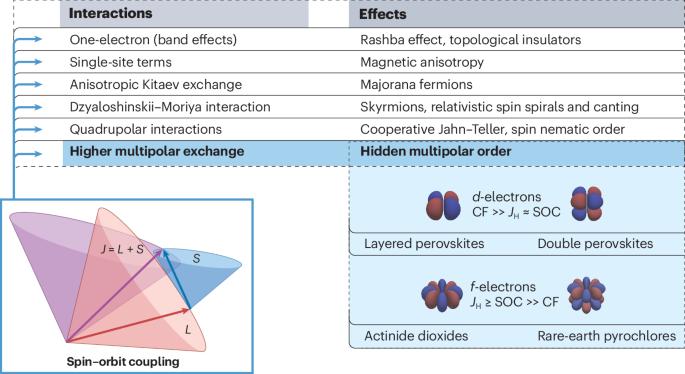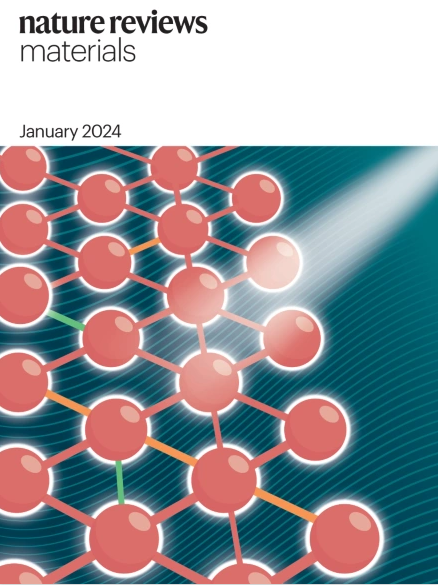自旋轨道纠缠相关绝缘子中的隐序
IF 86.2
1区 材料科学
Q1 MATERIALS SCIENCE, MULTIDISCIPLINARY
引用次数: 0
摘要
在许多材料中,有序相及其有序参数很容易用标准实验方法表征。“隐序”指的是一种相变,在这种相变中,尽管有明确的热力学证据,但有序状态的出现却没有这种容易检测到的顺序参数。这些非常规物质状态的潜在机制源于自旋-轨道耦合,它交织着场间交换、经典的电子-磁相互作用和电子-晶格效应。这种物理是难以捉摸的实验探测器和超出了传统的绝缘磁理论,需要复杂的方法来探索它。本文综述了相关绝缘体中奇异的隐序相,重点介绍了材料特异性理论和数值方法的最新进展。这些相的相关自由度是重d和重f电子离子的自旋轨道纠缠相关壳层产生的磁和电荷密度的局部高阶多极矩,并通过各种机制在晶格上相互作用。我们讨论了通过直接从头计算或通过构造低能多体有效哈密顿量来模拟现实系统中隐阶的方法。我们还描述了这些新的理论工具如何帮助揭示最近在重过渡金属双钙钛矿中发现的多极相的驱动机制,以及它们如何证明有助于解开“传统”f电子多极材料(如锕系二氧化物)中各种相互作用的作用。在这两种情况下,物质特异性理论在解释和预测隐藏顺序的实验特征方面发挥了关键作用。本文章由计算机程序翻译,如有差异,请以英文原文为准。


Hidden orders in spin–orbit-entangled correlated insulators
In many materials, ordered phases and their order parameters are easily characterized by standard experimental methods. ‘Hidden order’ refers to a phase transition in which an ordered state emerges without such an easily detectable order parameter, despite clear thermodynamic evidence of the transition. The underlying mechanisms for these unconventional states of matter stem from spin–orbit coupling, which intertwines intersite exchange, classical electron–magnetic interactions and electron–lattice effects. This physics is elusive to experimental probes and beyond traditional theories of insulating magnetism, requiring sophisticated methodologies for its exploration. In this Review, we survey exotic hidden-order phases in correlated insulators, particularly focusing on the latest progress in material-specific theories and numerical approaches. The relevant degrees of freedom in these phases are local high-rank multipole moments of magnetic and charge density that emerge from spin–orbit-entangled correlated shells of heavy d and f electron ions and interact on the lattice via various mechanisms. We discuss approaches to modelling hidden orders in realistic systems via direct ab initio calculations or by constructing low-energy many-body effective Hamiltonian. We also describe how these new theoretical tools have helped to uncover driving mechanisms for recently discovered multipolar phases in double perovskites of heavy transition metals and how they have proved instrumental in disentangling the role of various interactions in ‘traditional’ f-electron multipolar materials such as actinide dioxides. In both cases, material-specific theories have played a key part in interpreting and predicting experimental signatures of hidden orders. Hidden orders involve phase transitions without obvious order parameters, challenging experimental detection and conventional theories. This Review summarizes recent advances in modelling hidden-order phases in correlated insulators, highlighting the role of material-specific theories in the interpretation and prediction of the experimental signatures of hidden orders.
求助全文
通过发布文献求助,成功后即可免费获取论文全文。
去求助
来源期刊

Nature Reviews Materials
Materials Science-Biomaterials
CiteScore
119.40
自引率
0.40%
发文量
107
期刊介绍:
Nature Reviews Materials is an online-only journal that is published weekly. It covers a wide range of scientific disciplines within materials science. The journal includes Reviews, Perspectives, and Comments.
Nature Reviews Materials focuses on various aspects of materials science, including the making, measuring, modelling, and manufacturing of materials. It examines the entire process of materials science, from laboratory discovery to the development of functional devices.
 求助内容:
求助内容: 应助结果提醒方式:
应助结果提醒方式:


